Here you will learn formula for the volume of a frustum of a cone with derivation and examples based on it.
Let’s begin –
What is Frustum of Cone ?
Frustum of a cone is the solid obtained after removing the upper portion of the cone by a plane parallel to its base. The lower portion is the frustum of a cone.
Height : The perpendicular distance between the aforesaid plane and the base is called the height of the frustum.
Volume of a Frustum of a Cone
The formula for volume of a frustum of a cone is
V = \(h\over 3\)\([A_1 + \sqrt{A_1A_2} + A_2]\)
[\(A_1\), \(A_2\) are the areas of bottom and top of the frustum]
V = \(\pi h\over 3\)\([{r_1}^2 + \sqrt{r_1r_2} + {r_2}^2]\)
where h is the height of the frustum, \(r_1\), \(r_2\) are the radii of the base and the top of frustum of a cone.
Note : Height h of the frustum is given by the relation,
\(l^2\) = \(h^2\) + \((r_1 – r_2)^2\)
Also Read : Area of a Frustum of a Cone – Formula and Derivation
Derivation :
Let \(r_1\) and \(r_2\) be the radii of the bottom and top of the frustum respectively and h be the height of the frustum.
The frustum of a cone is the solid obtained after removing the upper portion (small cone) of it by a plane parallel to the base of the big cone.
Volume of frustum = Volume of bigger cone – Volume of smaller cone
= \(1\over 3\)\(\pi {r_1}^2 h_1\) – \(1\over 3\)\(\pi {r_2}^2 h_2\)
Since, [ \(h_1\over r_1\) = \(h_2\over r_2\) = k ]
= \(\pi k\over 3\)\([{r_1}^3 – {r_2}^3]\)
= \(\pi k\over 3\) (\(r_1 – r_2\)) \(({r_1}^2 + {r_1r_2} + {r_2}^2)\)
Volume = \(1\over 3\) (\(kr_1 – kr_2\)) \((\pi{r_1}^2 + \pi{r_1r_2} + \pi{r_2}^2)\)
V = \(1\over 3\) (\(h_1 – h_2\)) \((\pi{r_1}^2 + \sqrt{(\pi{r_1}^2)(\pi{r_2}^2)} + \pi{r_2}^2)\)
Volume = \(h\over 3\)\([A_1 + \sqrt{A_1A_2} + A_2]\)
Where \(A_1\), \(A_2\) are the areas of bottom and top of the frustum respectively and h = \(h_1 – h_2\).
Volume of frustum of Cone = \(h\over 3\)\([A_1 + \sqrt{A_1A_2} + A_2]\)
= \(h\over 3\) \((\pi{r_1}^2 + \sqrt{(\pi{r_1}^2)(\pi{r_2}^2)} + \pi{r_2}^2)\)
Volume = \(\pi h\over 3\)\([{r_1}^2 + \sqrt{r_1r_2} + {r_2}^2]\)
Example : A friction clutch is in the form of the frustum of a cone, the diameters of the ends being 8 cm, and 10 cm and length 8 cm. Find its Volume.
Solution : Here, radius,
\(r_1\) = \(10\over 2\) = 5cm,
\(r_2\) = \(8\over 2\) = 4cm
Slant height, l = 8 cm
Height h of the frustum is given by the relation,
\(l^2\) = \(h^2\) + \((r_1 – r_2)^2\)
\(\implies\) 64 = \(h^2\) + \((5 – 4)^2\) or \(h^2\) = 63 \(\implies\) h = 7.937
\(\therefore\) Volume = \(\pi h\over 3\)\([{r_1}^2 + \sqrt{r_1r_2} + {r_2}^2]\)
Volume = \(3.14 \times 7.937\over 3\) \(\times\) [25 + 20 + 16] = 506.75 \(cm^2\)
